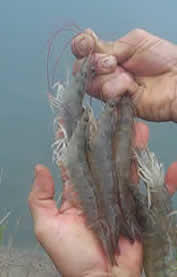BOLIGEE, Alabama -- In an effort to reduce incidences of disease and increase the survival rate, and subsequent yields, of farmed shrimp, an aquaculture farmer received a Southern SARE Producer Grant to determine if probiotics could be a sustainble way to boost the health of the animals. Probiotics are commonly used in hatcheries, but their effectiveness is limited in grow-out ponds.
David Teichert-Coddington of Greene Prairie Aquafarm in Boligee, AL, fed a mixture of three Bacillus species to shrimp on aquaculture farms in Alabama and Florida to protect against such diseases as Vibrio bacteria. The Bacillus species are known to increase growth and survival in shrimp by outcompeting with pathogenic bacteria and stimulate the immune system.
Results showed that the probiotics appeared to decrease the total numbers of pathogenic Vibrio bacteria in the ponds, hence reducing the numbers of shrimp that would be infected. However, survival and yields of shrimp at all test farms were low, with or without probiotic treatments.
There appeared to be a correlation between high Vibrio infections, high numbers of Oscillatoria (a blue-green algae) and high mortality rates in August, suggesting that toxins from algal blooms create additional stressors that weaken the shrimp.
“The viruses and bacterial infections were not the principal cause of mortality,” said Coddington. “The histology indicated that we should investigate more about the potential for algal toxins to harm our shrimp.”
Published by the Southern Region of the Sustainable Agriculture Research and Education (SARE) program. Funded by the USDA National Institute of Food and Agriculture (NIFA), Southern SARE operates under cooperative agreements with the University of Georgia, Fort Valley State University, and the Kerr Center for Sustainable Agriculture to offer competitive grants to advance sustainable agriculture in America's Southern region. This material is based upon work that is supported by the National Institute of Food and Agriculture, U.S. Department of Agriculture, through Southern Sustainable Agriculture Research and Education, under sub-award number: FS17-304. USDA is an equal opportunity employer and service provider. Any opinions, findings, conclusions, or recommendations expressed in this publication are those of the author(s) and do not necessarily reflect the view of the U.S. Department of Agriculture.
